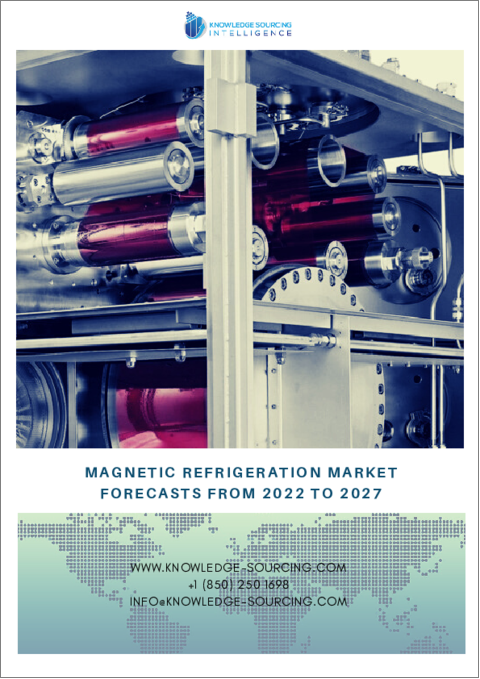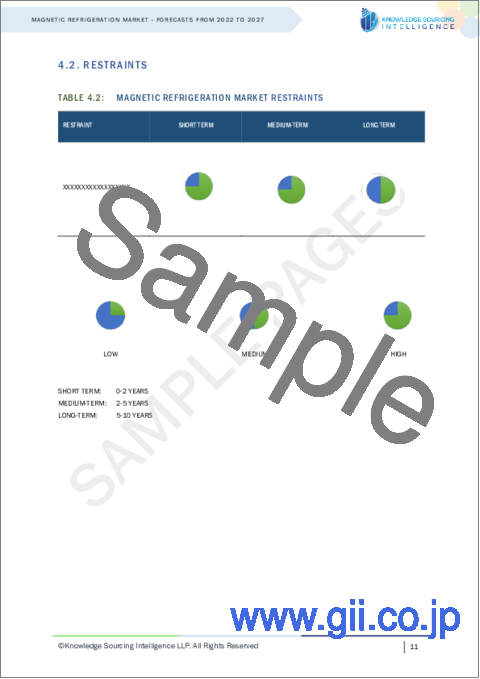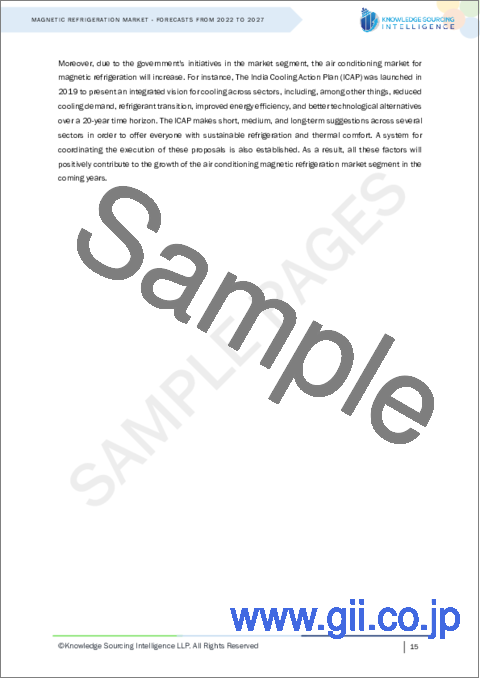|
|
市場調査レポート
商品コード
1122492
磁気冷凍の世界市場:予測(2022年~2027年)Magnetic Refrigeration Market - Forecasts from 2022 to 2027 |
||||||
|
● お客様のご希望に応じて、既存データの加工や未掲載情報(例:国別セグメント)の追加などの対応が可能です。 詳細はお問い合わせください。 |
|||||||
| 磁気冷凍の世界市場:予測(2022年~2027年) |
|
出版日: 2022年07月21日
発行: Knowledge Sourcing Intelligence
ページ情報: 英文 128 Pages
納期: 即日から翌営業日
|
- 全表示
- 概要
- 目次
世界の磁気冷凍の市場規模は、2020年の1,673万2,000米ドルから、2027年には2億9,534万6,000米ドルになると予測されており、2020年から2027年までの予測期間中のCAGRは50.70%となっています。冷却・加熱技術の代替品としての使用の増加は、磁気冷凍市場の成長を促進すると考えられます。しかし、磁気発熱材料の希少性による相対的な製造コストの高さが、市場の成長を抑制しています。
当レポートでは、世界の磁気冷凍市場について調査分析し、市場力学、市場分析、競合情報、企業プロファイルなど、体系的な情報を提供しています。
目次
第1章 イントロダクション
- 市場概要
- COVID-19シナリオ
- 市場の定義
- 市場セグメンテーション
第2章 調査手法
- 調査データ
- 仮定
第3章 エグゼクティブサマリー
- 調査のハイライト
第4章 市場力学
- 市場促進要因
- 市場抑制要因
- 市場機会
- ポーターのファイブフォース分析
- 供給企業の交渉力
- 買い手の交渉力
- 新規参入業者の脅威
- 代替品の脅威
- 業界での競争企業間の敵対関係
- 業界バリューチェーン分析
第5章 磁気冷凍市場分析:用途別
- イントロダクション
- 冷蔵庫
- 飲料クーラー
- ディスプレイ・冷菓用キャビネット
- 空調
第6章 磁気冷凍市場分析:エンドユーザー別
- イントロダクション
- 住宅
- 商業・工業
第7章 磁気冷凍市場分析:地域別
- イントロダクション
- 南北アメリカ
- 欧州、中東、アフリカ
- アジア太平洋地域
第8章 競合環境と分析
- 主要企業と戦略分析
- 新興企業と市場の収益性
- 合併、買収、契約、および提携
- ベンダーの競争力マトリックス
第9章 企業プロファイル
- Ubiblue
- Camfridge
- BASF SE
- VACUUMSCHMELZE GmbH & Co. KG
- MagnoTherm Solution
- CCS SA
- Astronautics Corporation of America
- kiutra GmbH
- AMT&C Group
The magnetic refrigeration market is estimated to grow at a CAGR of 50.70% to reach US$295.346 million in 2027 from US$16.732 million in 2020. There has been a growing emphasis on limiting global warming to less than 2 degrees Celsius by 2100. To achieve this, approximately 200 countries recently agreed to dramatically reduce their reliance on climate change-causing chemicals called hydrofluorocarbons (HFCs) in air conditioning and refrigeration. This refrigerant has a significantly higher potential to cause global warming in comparison to the use of carbon dioxide. Hence, research and usage of greener alternatives have been gaining traction recently. Magnetic refrigeration has been witnessing a rapid increase in its popularity and is considered an ideal replacement for the conventional cooling and heating technology that is used in refrigerators and air conditioners. The technology is based on exotic materials such as gadolinium and dysprosium - that heat up when a magnetic field is applied to them and cool down when the magnetic field is removed. The potential of magnetic refrigeration to reduce energy use by approximately 30% is its most attractive feature and is expected to be the prime driver of the market. However, relatively higher production costs due to the scarce availability of magnetocaloric materials are the main challenge for the industry. Moreover, the large-scale fabrication process between the device and the equipment that is required to be refrigerated is yet to be optimized to attain maximum efficiency, which is also hindering its adoption.
Regional View
According to the Japan Refrigeration and Air Conditioning Industry Association, the global air conditioner demand has increased from 104,367 thousand units in 2013 to 110,971 units in 2018, with emerging Asian and oceanic countries like India, Vietnam, Philippines, Bangladesh, Indonesia, Australia, and New Zealand being the prime growth drivers.
The air conditioner demand in the Asian countries (excluding China and Japan) has grown at a CAGR of 5.42%, while the oceanic continent too has witnessed a similar CAGR between 2013-2018. The expanding middle-class sector as a result of growing urbanization has been instrumental in driving the HVAC industry.
Japan continues to hold its position on the list of the most developed economies in the world. A fast-paced lifestyle is one of the major factors shaping the growth of hospitality and supermarket infrastructure investment. Booming industries have not only been driving the economic engine of the country but have also been improving the living standards of people. As people's disposable income is high, socializing at restaurants is common. Furthermore, the presence of a good number of restaurants offering everything from a delightful ambience to good food has been contributing significantly to the increasing footfall, thus contributing to the market growth. The hotel industry continues to benefit from the strong position of the country in international business. A large number of people arriving in the country for business purposes is significantly contributing to the growth in hotel revenue. Thus, the growing hospitality industry and the simultaneous focus on controlling climate change are estimated to drive the magnetic refrigerant market growth in Japan. Similarly, in China, the growth of the market in this country is majorly attributed to the growing middle-class population on account of increasing wages, which is close to the solid economic growth the country has been witnessing due to the rapid growth of industries and a huge inflow of investments by industry players into various sectors. According to data from the Direct China Chamber of Commerce (DCCC), the middle-class population in China is expected to expand from 430 million in 2019 to 780 million by 2025. The increasing inclination of youth towards western culture is evident from the rapidly increasing footfall at restaurants, coffee houses, and bars across the country. According to DCCC, middle-class youngsters account for around 75% of the customers that restaurants, coffee houses, and bars cater to. To tap this immense growth potential, many restaurants, fast food, bar, and coffee house chains are making huge investments. According to data from the Direct China Chamber of Commerce, Starbucks is planning to double the number of its coffee shops in China from around 3,300 now to over 6,000 over the next five years. This scenario was expected to continue driving the market growth in the country from 2020 to 2025. Thus, China is estimated to possess the largest addressable market, with great potential for the clean technology estimated to be unlocked in the country.
Key Developments in the Market:
- The ongoing exhaustive studies to develop innovative and sustainable refrigerators with magnetocaloric technology are expected to propel market growth.
- In March 2020, an exhaustive study report on this promising technology-magnetocaloric-which could be the next generation of refrigeration and cooling was published by researchers from the Oak Ridge National Laboratory and CEMAC (Clean Energy Manufacturing Analysis Center).
- In December 2021, Virginia Commonwealth Fund invested in Stephen Fong's project of designing and developing a modular refrigerator. The core of this eco-friendly modular refrigerator is magnetic refrigeration technology. The main objective of Stephen Fong is to develop a sustainable long-term refrigeration solution.
COVID-19 Impact:
COVID-19 had a negative impact on the Magnetic Refrigeration Market. The surge of infected cases led to quarantine and the complete closure of public facilities. The closure of restaurants and food outlets along with the production facilities has led to decreased demand and productivity. Consequently, the market growth slowed down.
Market Segmentation:
- By Application
Refrigerator
Beverage Coolers
Display and Ice cream cabinets
Air Conditioning
- By End-User
Residential
Commercial and Industrial
- By Geography
Americas
Europe Middle East and Africa
Asia Pacific
TABLE OF CONTENTS
1. INTRODUCTION
- 1.1. Market Overview
- 1.2. Covid-19 Scenario
- 1.3. Market Definition
- 1.4. Market Segmentation
2. RESEARCH METHODOLOGY
- 2.1. Research Data
- 2.2. Assumptions
3. EXECUTIVE SUMMARY
- 3.1. Research Highlights
4. MARKET DYNAMICS
- 4.1. Market Drivers
- 4.2. Market Restraints
- 4.3. Market Opportunities
- 4.4. Porter's Five Force Analysis
- 4.4.1. Bargaining Power of Suppliers
- 4.4.2. Bargaining Power of Buyers
- 4.4.3. Threat of New Entrants
- 4.4.4. Threat of Substitutes
- 4.4.5. Competitive Rivalry in the Industry
- 4.5. Industry Value Chain Analysis
5. MAGNETIC REFRIGERATION MARKET ANALYSIS, BY APPLICATION
- 5.1. Introduction
- 5.2. Refrigerator
- 5.3. Beverage Coolers
- 5.4. Display and Ice cream cabinets
- 5.5. Air Conditioning
6. MAGNETIC REFRIGERATION MARKET ANALYSIS, BY END-USER
- 6.1. Introduction
- 6.2. Residential
- 6.3. Commercial and Industrial
7. MAGNETIC REFRIGERATION MARKET ANALYSIS, BY GEOGRAPHY
- 7.1. Introduction
- 7.2. Americas
- 7.3. Europe Middle East and Africa
- 7.4. Asia Pacific
8. COMPETITIVE ENVIRONMENT AND ANALYSIS
- 8.1. Major Players and Strategy Analysis
- 8.2. Emerging Players and Market Lucrativeness
- 8.3. Mergers, Acquisitions, Agreements, and Collaborations
- 8.4. Vendor Competitiveness Matrix
9. COMPANY PROFILES
- 9.1. Ubiblue
- 9.2. Camfridge
- 9.3. BASF SE
- 9.4. VACUUMSCHMELZE GmbH & Co. KG
- 9.5. MagnoTherm Solution
- 9.6. CCS SA
- 9.7. Astronautics Corporation of America
- 9.8. kiutra GmbH
- 9.9. AMT&C Group




